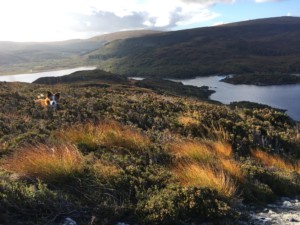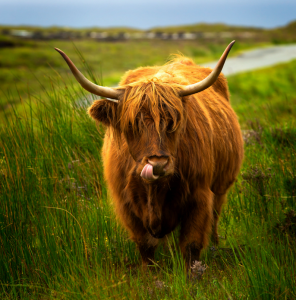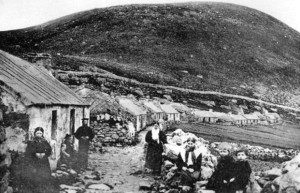
Words From the Woods: Meditations on Invasive Species
As I was taking my daily womble through the woods, I was thinking about one of the challenges we face on the isle of Carna where we’re piloting many of our Wilderculture rewilding techniques.
The issue pressing on my brain is that of the invasive species Rhododendron ponticum. Originating from an introduced ornamental seed source on the mainland, this problematic pest plant has invaded the north of the island and if left unchecked would take over the whole island ecosystem leaving little room for the native habitats to thrive.

In conventional ecology, it’s deemed that all non-native species are ‘bad’ as they out-compete the native species which aren’t adapted to ‘fight’ them for resources. In Holistic management we have a slightly different view, we believe that biodiversity is king and in fact the reason our habitats are so vulnerable to invasive species is because they are generally in a low state of succession.
The more complex the ecosystem and its soil, the more resilient it is to ‘plagues’ or ‘booms’ of species regardless of their being native or invasive.
I noticed on a recent visit to the Island of Rhum in Scotland which is a SNH nature reserve. On this stunning Island the deer numbers have been kept at a sustainable level and there has been no overgrazing from livestock, use of modern fertilisers and pesticides and no tillage of the land the result is a moorland habitat that includes great biodiversity with little bare soil.
On all of the surrounding overgrazed islands there is a bracken issue – an invasive species that has taken over much of the UK uplands – but on Rhum even though there are few patches here and there by the trampled pathways, the main islands heathland has remained practically bracken free.
This set my usual train of vaguely connected thoughts rolling. I started relating this to our food systems and human well-being.
Once upon a time, before we could travel large distances, people were in tune with their environment. We collected food from our immediate area and intimately knew each corner of this small piece of the world; every species, their behaviour, and the conditions they required for optimal health – it was essential to our survival.
This awareness and alertness to our surroundings helped ground us. It rooted us to a place; part of the ecosystem and fully connected.
In our modern Western world the opposite is true. We’re now very disconnected from our environment and at no less consequence to our survival than when we were hunter gatherers.
Our reliance on supermarkets has allowed us to select food with no thought to where in the world it has been grown or gathered, or with what impact that growing had on the local people and their ecosystem.

We’re shunning local meats that can be grown from our surrounding landscape for soya and nut products that are grown on land far across the world. The production of these is responsible for degrading some of the most bio-diverse habitats in the world, along with persecuting the apex predators of these important ecosystems – the last of the true indigenous human peoples.
These native cultures would have been a part of their landscape. Their gut microbiome cultured from the very organisms that make up their native soils, which grow their native plants and native animals. These people were adapted well to fight the infections and diseases that were common in these parts.
Just as our environment is susceptible to invasive plant and animal species, these indigenous human cultures were susceptible to the incoming Westerners bringing diseases against which their gut flora isn’t able to fully protect.
But was the real problem these foreign diseases, or was it the degrading effect of the other modern cultural practices, technologies and foods brought by these ‘advanced’ peoples that rendered the locals more susceptible to disease?
St Kilda lies more than 40 miles west of the Outer Hebrides off Scotland’s north-west coast has been successfully inhabited for at least two millennia.
The first reports of life on the Island suggested that survival was possible by utilising freshwater springs, and for centuries the islanders survived by eating the meat and eggs of seabirds, fish caught near the islands, and probably harvested seaweeds and shellfish. Latterly this diet would have been supplemented with some simple home grown meat and grain as advances in agriculture slowly filtered into their culture.
Then everything started to change.
In 1615 Coll MacDonald of Colonsay raided Hirta, removing 30 sheep and a quantity of barley. Thereafter, the islands developed a reputation for abundance.
At the time of Island writer Martin Martin’s visit in 1697 the population was 180 and the steward travelled with a “company” of up to 60 persons to which he “elected the most ‘meagre’ among his friends in the neighbouring islands, to that number and took them periodically to St. Kilda to enjoy the nourishing and plentiful, if primitive, fare of the island, and so be restored to their wonted health and strength.”
 Image from Tour Scotland, tour-scotland-photographs.blogspot.com/2015/07/old-photograph-cottages-and-islanders.html
Image from Tour Scotland, tour-scotland-photographs.blogspot.com/2015/07/old-photograph-cottages-and-islanders.html
By 1885 J Acheson, a surgeon, reported that food was abundant on St Kilda but lacked variety. There were no fruit or vegetables, apart from a few poor quality potatoes. The islanders ate oatmeal, salted fowl, and seabird eggs during summer and salted mutton in winter. They obtained tea, sugar, flour and tobacco from tourists and from the owner’s factor (Agriculture and Fisheries Department file, AF57/5).
Today the Island is no longer inhabited due to the reported poverty and susceptibility to disease of these ‘stricken’ hungry people. An outbreak of small pox reduced the Island population dramatically and it was eventually evacuated in 1930.
So was it the lack of food and poor housing that led to the demise of these hardy people? Or was it an increased reliance on the processed agricultural foods that are so well known to lead to poor health and reduced resilience to disease?
Perhaps it was a combination of both?
So back to our invasive species issue on the Isle of Carna. Thank goodness we have a grant from the Forestry Commission to help address the invasion. We are also lucky enough to have a local team who have developed a superbly effective technique to rid us of these persistent triffids. But our aim for the Island is to make the Island so bio-diverse and resilient that it can ‘fight’ off these pesky invaders better in the future.
I like this analogy for how we address our health too.
Enjoyed this article? Read another Words From The Woods Thread here.


No Comments